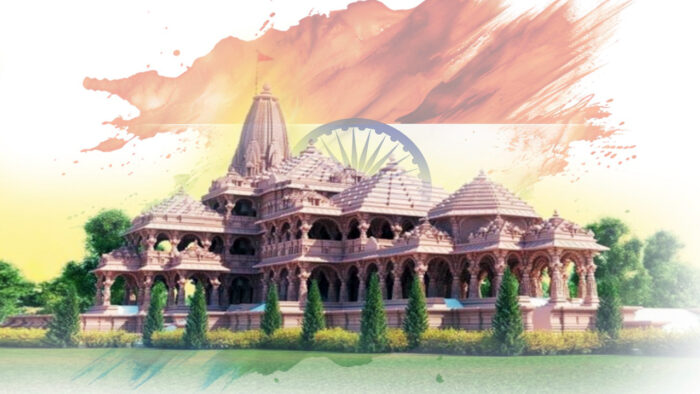The Ram Temple as a Unifying Force
The Pran Pratishta of the Ram Temple in Ayodhya marks a significant chapter in India’s history, embodying the ideals of Hindu unity and reflecting the aspirations of Prime Minister Narendra Modi’s vision for a New India. It is a moment to reflect on a journey interwoven with faith, history, devotion, and patience, all underpinning the theme of Hindu unity. The reconstruction of the temple is also an important milestone in India’s decolonization journey. This article explores how the Ram Temple represents a pinnacle in India’s socio-cultural evolution and resonates with the country’s intrinsic pluralism and its advancing stride towards Hindu unity and global prominence.
Faith, Challenges, and Political Milestones
The path to the Ram Temple’s establishment is interwoven with deep-rooted faith, societal challenges, and significant political events. Central to this journey is the issue of caste, a longstanding challenge within Hindu society. The caste system has often posed a barrier to the realization of true Hindu unity. This internal fragmentation was brought to the forefront in 1981 by the Meenakshipuram conversions, where a group of Dalits in Tamil Nadu embraced Islam, sending shockwaves across the country. The event highlighted the urgent need for inclusivity and reform within Hinduism and raised profound questions about the community’s internal solidarity and the role of caste within it.
The Ram Temple’s establishment is emblematic of the Hindu community’s spiritual commitment and its quest for religious expression. This devotion, however, is juxtaposed against the backdrop of societal challenges, particularly the entrenched caste system, which has historically fragmented Hindu society and hindered the realization of a cohesive community identity. The Meenakshipuram conversions were a stark reminder of these divisions, igniting a widespread call for greater inclusivity and reform within Hinduism. Politically, the temple’s construction became a focal point in the 80s and the 90s. It served as a symbol around which a few political entities and leaders rallied, reflecting the complex interplay between religious identity and political strategy. As such, the temple’s narrative weaved together the threads of faith, social dynamics, and political aspirations, highlighting the multifaceted nature of this monumental endeavor.
The Ram Janmabhoomi Movement, A Turning Point in Indian Politics
Amidst the backdrop of the Meenakshipuram conversions, the 1980s were also a period of significant political upheaval in India, influencing the trajectory of the Ram Janmabhoomi movement. Decisions made by Prime Ministers, Rajiv Gandhi and V.P. Singh had lasting impacts on the Hindu community. Rajiv Gandhi’s mishandling of the Shah Bano case, where he overturned a court judgment favoring maintenance for a divorced Muslim woman, and V.P. Singh’s implementation of the Mandal Commission recommendations for increased reservation for backward classes, ignited a sense of disenchantment and mobilization among Hindus.
In this charged environment, the Ram Janmabhoomi movement emerged as a powerful catalyst for the Hindu unit and a pivotal moment in reclaiming cultural and religious landmarks. The movement, centered around the birthplace of Bhagwan Ram, marked the historic reconstruction of the Ram Mandir, notably becoming the first temple to be rebuilt outside of Europe on land previously taken over by marauding Islamic invaders. This achievement transcended mere religious symbolism; it became a rallying point for addressing broader issues of cultural identity and national heritage.
The political climate, marked by perceived threats to Hindu interests, galvanized support for the movement, making it a significant force in Indian politics. The movement aimed not just at the temple’s construction but at unifying diverse sections of the Hindu community, overcoming caste barriers and regional differences, and heralding a new era of Hindu nationalism.
Economic and Social Implications of Hindu Unity
The unity forged through the Ram Temple movement has far-reaching implications beyond the religious and political realms. Economically, a unified community provides a stable and harmonious environment conducive to growth and development. It fosters investor confidence, encourages domestic and foreign investment, and stimulates economic innovation. In a nation where cultural dynamics often influence economic decisions, the unity and solidarity demonstrated in this movement can be a powerful driver of economic prosperity.
Socially, the movement towards Hindu unity has the potential to bridge historical divides, fostering a sense of collective identity and national pride. This social harmony is crucial in a country as diverse as India, where unity in diversity is not just a slogan but a foundational principle. By transcending caste and regional disparities, the Hindu community can play a pivotal role in creating a more inclusive and harmonious society.
Embracing Unity for a Progressive and Resilient India
The Ram Temple in Ayodhya stands as a clear example of what can be achieved when a community unites for a common goal. It’s a reminder of the power of faith and the importance of overcoming challenges together. As India moves towards a future as a global leader, the unity and lessons learned from the journey of the Ram Temple are vital. Embracing this unity is key to building a New India, one that grows economically and remains politically stable through the strength of its united people.
This unity is especially important in the Hindu community, helping to bridge social and economic gaps. It’s crucial now more than ever for the Hindu Parivar to learn to walk together, strengthening their unity to face the challenges and opportunities ahead. The Ram Temple is more than just a religious site; it’s a symbol of hope, unity, and the potential for a better future. It shows a way forward for India, a path towards prosperity and social harmony.
In the spirit of collaboration that characterized the reconstruction of the Ram Temple, communities transcended boundaries, pooling resources and efforts in an unprecedented display of unity. Artisans, laborers, and volunteers from every corner of the nation contributed their skills, while individuals, irrespective of their social or economic standing, offered donations. This joint endeavor, marked by shared rituals and prayers, not only laid the stones of the temple but also strengthened the bonds within the community, crafting a tapestry of solidarity and shared purpose. The temple’s reconstruction thus stands as a testament to the power of collective will and the unifying strength of a shared cultural heritage.
By uniting in this way, India sets a global example. The story of the Ram Temple is thus a testament to the lasting power of faith and unity in shaping a country’s future, making it a key part of the story of a rejuvenated New India. As we embrace this path, the call for Hindu unity grows louder, urging the community to consolidate its strengths, celebrate its diversity, and move forward with a shared vision for a harmonious and prosperous future.
References
- Hindu Civilization’s Sacred Space, Indica Today.
- A 500 Year Struggle, Hindupost.
- Cultural Renaissance, Indian Express.
- Civilizational Connect,Sunday Guardian.
- Meenakshipuram Conversions in Tamil Nadu, The Week.
- Hindus didn’t give up, India Facts.
- Dr Mohan Bhagwat’s address at the World Hindu Congress 2023, World Hindu Congress.
- https://www.youtube.com/watch?v=6PKIoXzke5M –
Disclaimer: The opinions expressed in this article belong to the author. Indic Today is neither responsible nor liable for the accuracy, completeness, suitability, or validity of any information in the article.











